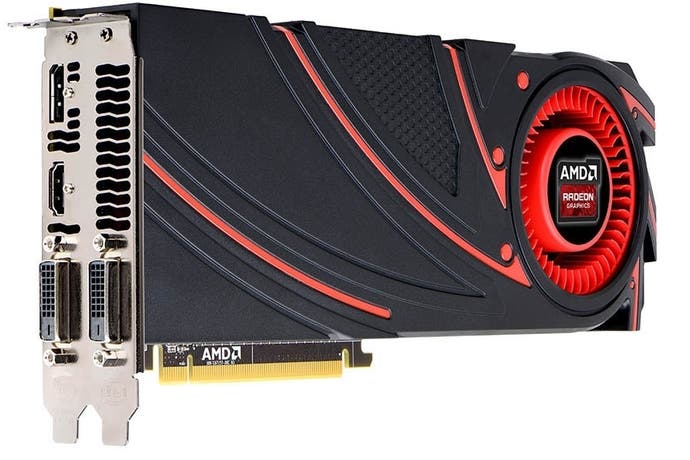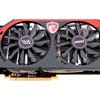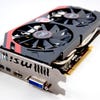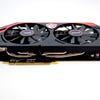Radeon R9 280X review
Price war.
Let's start by talking about what the Radeon R9 280X isn't. Despite relying on the same technology for almost two years now, we're not seeing the arrival of new AMD architecture here. This card is Graphics Core Next through and through, and it's very easy indeed to level the accusation that AMD is simply rebranding existing cards, adding a handful of new features to the firmware but fundamentally re-releasing the same product.
With the R9 280X we're looking at a card that is remarkably similar to the existing Radeon HD 7970 GHz Edition. Indeed, when we first installed the card with the current AMD drivers present on our test PC, it was even recognised as a 7900-series product - and it seemed to work just fine. Only with the arrival of AMD beta drivers did Windows recognise the R9 280X as a different product.
So by extension, clearly the Radeon R9 280X isn't the much-vaunted challenger to Nvidia's unchallenged GeForce GTX 780 or the stratospherically expensive enthusiasts' favourite - the GTX Titan. That's the R9 290X, and while we can acknowledge its existence, curiously the new AMD flagship still remains under NDA - for now.
So is it really possible to show any kind of enthusiasm for a card that is - at the most basic level - a highly clocked version of the same product that first debuted at the tail-end of 2011? Actually, yes. You see, in last week's Radeon HD 7990 review, we actually bought in a 7970 GHz Edition card for reference, so we're coming to this replacement with the older product very fresh in our minds. We were pretty impressed with it then, and in its R9 280X guise we can't help but give it a more emphatic recommendation.
The reasons are three-fold. Firstly and most importantly, there's the price - last week's £300+ product now commands a much more reasonable £250 sticker price, according to AMD partner MSI. Indeed, just six months ago, 7970 GHz Edition cards would set you back as much as £380. Secondly, the performance is undeniable - across our benchmarks, not to mention our Crysis 3 gameplay stress test, the R9 280X presents a serious challenge to the (now) significantly more expensive GeForce GTX 770. And finally, there's the construction of the product. Our Sapphire Vapor-X 7970 GHz Edition had the raw performance, and while it may just have been an issue with our specific card, it proved remarkably loud under load, despite featuring an impressive custom cooler. For the new product launch, AMD dispatched an MSI Twin Frozr custom variant of the R9 280X for review and it's the quietest high-end Radeon we've tested.
Underneath the impressive cooling set-up, we have the standard Tahiti silicon that has served AMD well over the last couple of years. There are 32 GCN compute units running at 1.05GHz, working in combination with a 384-bit interface hooked up to 3GB of GDDR5 memory, running at 1500MHz (6GHz effective). The end result is 4.3TF of compute power on tap. Now, raw numbers like that need to be taken with a pinch of salt when judging what this means for gameplay, but regardless, assuming that the £250 price holds true, that's a vast amount of GPU power at a very reasonable price.
Translated into our Crysis 3 gameplay stress test, you're looking at ballpark GTX 770 frame-rates at the exact same quality settings. The test in question takes place on the second level - dubbed "Welcome to the Jungle" - a mixture of outdoors arboreal environments and close quarters interior battles, reaching its crescendo with an on-rails set-piece that really puts the CryEngine technology - and the GPU running it - through its paces in one of the game's most spectacular sequences.
For the R9 280X, we're running at our tier-two quality settings. Performance is handicapped at the very high preset, so we drop down to high, but we retain the top-end textures, we engage v-sync and implement SMAA 2x - a mixture of temporal and post-process anti-aliasing that provides good coverage while not killing performance. The very high setting? Well, cards like this and the GTX 770 produce a playable experience, but anything approaching 1080p60 is off table.
"Crysis 3 exerts a huge workload from any GPU and we find that the R9 280X competes well with the GeForce GTX 770 and AMD's existing HD 7970 GHz Edition."
To be clear, our Crysis 3 test isn't the way to test maximum theoretical throughput of the card - that comes later - but perhaps more importantly it represents how we want to play this visually spectacular game: with as much bling as we can muster while retaining something approaching a 60fps experience. We compare gameplay frame-rates at the two most popular enthusiast display resolutions - 1080p and 2560x1440 - across five different areas of the stage. The result sees the R9 280X matching the GTX 770 in most situations, and even exceeding it in others based on like-for-like analysis.
Moving on the benchmarks, we also see much the same story. GPU vendors tend to suggest that any card over £150/$200 should be able to run 1080p gaming with all the settings ramped up to the max (though notably, Crysis 3 tends to be omitted from supplied benchmarks, or dialled back) so that's exactly where we pitch our full HD tests. We use a series of in-game benchmarks in order to replicate the exact same rendering loads on each graphics card, and in all cases, the GPU is matched by with a Core i7 3770K running at 4.3GHz, along with 16GB of DDR3 memory running at 1600MHz. The idea here is to ensure that CPU isn't the bottleneck.
It is worth pointing out that ramping up quality presets to the extremes probably isn't the way that most people actually use their hardware. Metro: Last Light and Sleeping Dogs both have the super-sampling option ticked, and they both use a form of post-process anti-aliasing too. Similarly, Hitman: Absolution at max settings combines FXAA and 8x multi-sampling AA for what is complete overkill. Of all the benches, we would say that the Tomb Raider and BioShock stats are probably the closest you'll get to actual gameplay results.
However, AMD and Nvidia promise good frame-rates at the absolute max, and it certainly allows us to judge relative performance between each of our test GPUs. The results offer a narrow AMD win for the most part, though in real life gaming conditions, you really wouldn't be able to tell the difference between the GTX 770 and this new card.
"The R9 280X acquits itself very well throughout our 1080p/max settings benchmarks, toe-to-toe with Nvidia's GK104 cards in many of the tests, beating the GTX 770 in bandwidth-heavy scenarios."
| 1920x1080 | R9 280X | GTX 770 | HD 7970 GHz | HD 7970 | GTX 760 |
|---|---|---|---|---|---|
| BioShock Infinite, DX11 Ultra DDOF | 74.9fps | 77.3fps | 73.1fps | 65.9fps | 65.9fps |
| Tomb Raider, Ultra, FXAA | 95.5fps | 94.2fps | 94.8fps | 85.6fps | 76.8fps |
| Metro 2033, Very High, 4x MSAA | 42.1fps | 33.5fps | 40.8fps | 36.0fps | 31.5fps |
| Metro: Last Light, Very High, SSAA | 34.1fps | 33.5fps | 31.6fps | 28.8fps | 27.0fps |
| Hitman: Absolution, Ultra, 8x MSAA | 40.0fps | 33.7fps | 41.0fps | 36.5fps | 31.0fps |
| Sleeping Dogs, Extreme | 51.0fps | 48.0fps | 50.9fps | 46.4fps | 41.1fps |
Moving on to 2560x1440 tests, we try to introduce a touch of reality into the testing procedure. We're increasing pixel load by around 77 per cent, meaning that some compromise is required on the quality preset front in order to maintain reasonable performance. In all cases, we reduce the overall settings down a notch - so BioShock Infinite's ultra setting is pared back to very high, Tomb Raider ultra becomes high, Sleeping Dogs extreme is replaced by high - and so on.
It quickly becomes very clear that the definition of ultra settings varies drastically from one developer to the next. In the case of Tomb Raider, reducing the quality preset incurs very little impact to overall image quality, but the frame-rates shoot up significantly. In the case of Hitman: Absolution, there's a more modest reduction. Continuing the theme of attempting to introduce some reality to the metrics, we turn off super-sampling AA in Metro: Last Light and run two tests on Metro 2033 and Hitman - to illustrate how much performance is lost by the introduction of MSAA. In the case of Hitman, frame-rates sky-rocket if you drop back to 2x MSAA from the 8x equivalent. Because FXAA is also implemented, the impact to image quality is far less of an issue than you may expect. In short, the quest for max settings sees ever-increasing GPU resources utilised for often diminishing returns, when the technology may be better deployed in the pursuit of higher frame-rates.
Again, we see a straight battle between the GTX 770, the R9 280X and the Radeon HD 7970 GHz Edition. AMD pulls ahead by the smallest of margins in most of the tests, except in Metro 2033 and Hitman: Absolution - bandwidth-heavy assaults on the GPU that AMD makes the most of via its wider memory bus. The only additional footnote we should add to the GTX 770 vs. R9 280X face-off is that the new AMD card is clocked pretty much to its limits, while most GTX 770s should overclock to a degree that adds anything up to another 10 per cent to its stock performance.
"At 2560x1440 we dial back settings a touch and test key games with varying anti-aliasing levels - the results lift frame-rates considerably and don't impact image quality that much."
| 2560x1440 | R9 280X | GTX 770 | HD 7970 GHz | HD 7970 | GTX 760 |
|---|---|---|---|---|---|
| BioShock Infinite, DX11 Very High | 74.8fps | 74.7fps | 75.4fps | 67.7fps | 60.0fps |
| Tomb Raider, High, FXAA | 87.1fps | 93.1fps | 84.2fps | 76.0fps | 73.4fps |
| Metro 2033, High, 4x MSAA/AAA | 33.5fps/ 36.8fps | 26.5fps/ 33.0fps | 28.8fps/ 33.8fps | 27.7fps/ 31.7fps | 24.5fps/ 31.0fps |
| Metro: Last Light, High, No SSAA | 44.8fps | 43.0fps | 40.6fps | 36.7fps | 34.5fps |
| Hitman: Absolution, High, 8x MSAA/2x MSAA | 27.8fps/ 52.8fps | 22.8fps/ 45.2fps | 28.1fps/ 53.4fps | 25.4fps/ 40.7fps | 19.6fps/ 37.9fps |
| Sleeping Dogs, High | 60.4fps | 56.8fps | 61.4fps | 55.3fps | 47.4fps |
Radeon R9 280X: the Digital Foundry verdict
AMD's GCN architecture is no spring chicken, and we can't help but feel that the new naming structure is designed - in part - to make older products look more fresh and interesting than they actually are. At GPU14, AMD revealed a new technology including dedicated audio silicon, but that won't be appearing in the R9 280X, or its cheaper 270X sibling - and that's entirely down to the age of the base silicon. The old Tahiti and Pitcairn chips pre-date the arrival of the TrueAudio module - which will only appear in the 260X (a rebadged HD 7790, which actually has the audio hardware on the silicon in a deactivated form) and the flagship 290 series. However, firmware tweaks have been made, so there is now the ability to run three EyeFinity displays simultaneously (the displays must be identical, however) - a nice, if somewhat niche feature that won't be made available to owners of 7900-series cards.
The good news is that, in common with every GCN card on the market, you do get access to another new AMD exclusive: the Mantle API - a console-like interface to the GPU with potentially explosive performance gains over DirectX 11 and OpenGL. Battlefield 4 will be the first game to support it, with the Mantle upgrade set to ship in December, five or six weeks after the game launches. More news about Mantle, including further partner support, will be revealed in November and we're eager to find out how widely adopted the new API will be. If we have one concern about Mantle, it's that we have no idea if it scales beyond the GCN tech. It's hard to believe that next year's AMD cards will still be using GCN, and if Mantle doesn't work on future cards, we wonder how many developers will want to invest in it when embracing OpenGL opens up so many more options (SteamOS, Mac - and mobile, potentially).
"AMD offers more value than Nvidia for now, but in the short term, the R9 280X's biggest competitor is AMD's own 7970 GHz Edition - now being cleared out at super-cheap prices, often with bundles of free games."
While the R9 280X doesn't represent anything fundamentally new in the graphics space, it does at least make superb PC gaming performance a lot cheaper than it was previously - and that's something we can wholeheartedly get behind. The question is, should you buy the new card, or opt instead for the Radeon HD 7970 GHz Edition, which is fundamentally the same product? It'll all come down to the discounts we see as retailers look to shift their old stock. Bearing in mind the price-cutting we saw on the GTX 670 recently (we saw this card sell for as low as £165 at one point - realistically you'd need to spend over £500 on a GPU for a truly significant leap in performance), we could well see the 7970 priced aggressively against its successor - and you'll get the Never Settle three game bundle thrown into the bargain too.
AMD actually anticipated that reviewers would present this line of argument and suggested in a recent press release that the older cards wouldn't be available for much longer, and that we should instead focus on price comparisons with the competition instead. That would be a persuasive argument were it not for the fact that the market doesn't operate in a vacuum - we fully expect Nvidia to respond with price-cutting of its own in order to restore price/performance parity.
But until that happens, AMD - and the gamer - is on to a winner. Whether you're buying the old 7900-series cards or the new R9 280X, the value proposition on offer here is currently in a class of its own.

















